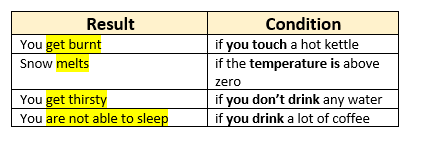A quick quiz. Read the questions below and answer them as fast as possible. Don’t think too much about the answers:
- What happens when you touch a hot kettle?
- What happens to snow when the temperature is above zero?
- What happens when you don’t drink any water?
- What happens when people drink a lot of coffee?
Great! Now compare your answers with the most common ones we collected around the school:
- You get burnt
- It melts
- You get thirsty/dehydrated
- You can’t sleep
Why was it so easy to get similar answers to this quiz? Mainly because the situations described are very common and you can’t think of any other options except for the most logical ones (with little variations, of course 😊). And it gets us to the point where we can use zero conditionals when talking about the result of the condition which is always true, like a scientific fact. No doubt that a hot kettle can burn you, or snow melts when the temperature is above zero. One can hardly argue these facts, can’t they? 😉
So, if we reformulate the sentences from the quiz using zero conditional pattern it will look like this:

As you can see (and probably you have experienced it yourself) the result is an absolute certainty. It doesn’t depend on the past, present or future. It is a simple fact, that’s why we use Present Simple tense to talk about the condition and the same tense, Present Simple tense, to describe the result, which is always the same.

Have you noticed anything? Right! You can easily change the order of the result–condition, or condition–result. However, have look at the punctuation. If you have the condition first, you have to put a comma after the clause (that was another example of zero conditional 😉) but you don’t need a comma if you change the order of the clauses (another zero conditional example). Easy right?
